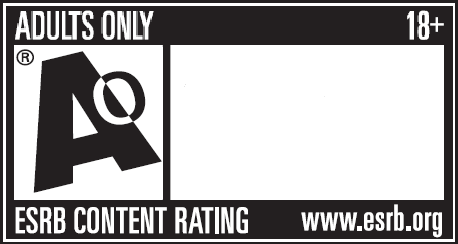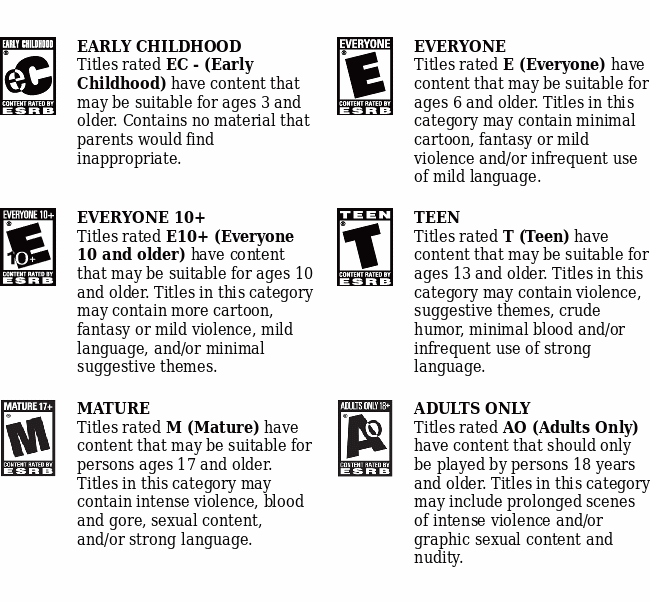The ESRB. It’s here on GameSkinny, every time you go to GameStop or Game ‘n Play. You see its mark every time you pick up your game, and before you put it in your PS3, PS4, Xbox, Wii, PC etc.
So what is it?
Implicated in the USA as well as nearly all of Canada and Mexico, the Entertainment Software Rating Board, or ESRB, is a non-profit association that develops the rating system for the video games we use every day. Usually, You can see the results of their process in the left-hand corner of your game. Here’s a chart of their ratings:
But how did the ESRB start and why was it needed?
The ESRB started in 1994, originally named the Interactive Digital Software Association. As opposed to the 7 ratings shown above, there were only 5 at this time.
This organization was implemented in order to create a designation by which parents could purchase games more appropriate for their intended gamer, and gamers in general would know what kind of content a game would have.
This is their official mission statement:
To empower consumers, especially parents, with guidance that allows them to make informed decisions about the age-appropriateness and suitability of video games and apps while holding the video game industry accountable for responsible marketing practices.
This association reviews games in one of two ways — a short and a long version based on how the game will be released. If the game is packaged, then it will be judged before its release by an online questionnaire detailing pertinent content. After this, a CD must be created that includes each scene within any aspect of the game (missions/cutscenes etc.) featuring content that would relate to any of the categories in question. The CD is then reviewed by three rating experts who then summarize their findings and a general rating statement and finally determine the appropriate marker.
After the game is released, select ones are play-tested to ensure accurate ratings were achieved.
Categories included in rating determinations are:
- Alcohol Reference
- Animated Blood
- Blood
- Blood and Gore
- Cartoon Violence
- Comic Mischief
- Crude Humor
- Drug Reference
- Fantasy Violence
- Intense Violence
- Language
- Lyrics
- Mature Humor
- Nudity
- Partial Nudity
- Real Gambling
- Sexual Content
- Sexual Themes
- Sexual Violence
- Simulated Gambling
- Strong Language
- Strong Lyrics
- Strong Sexual Content
- Suggestive Themes
- Tobacco Reference
- Use of Alcohol
- Use of Drugs
- Use of Tobacco
- Violence
- Violent References
If the game is an online download, then the creators must complete a series of multiple-choice questions that address content according to the categories of the ESRB. These questions include interactive components, whether or not the game enables the purchase of digital goods, and/or whether unrestricted Internet access is provided. The responses to these questions automatically determine the game’s Rating Category, Content Descriptors, and Interactive Elements.
These ratings help buyers become aware of content and information that will be shared through the games they are purchasing, as well as what information they may be sharing through their accounts by playing.
Nowadays game content goes beyond scenes within the games, and also includes online interaction and account information sharing. As such, these ratings are constantly being revised in order to better fit the ever-expanding content of gameplay.
The ESRB monitors/assesses how functional these ratings are/ how aware parents are of the ratings themselves.
Their most recent assessment showed that 84% of parents are aware of the ESRB rating system, 69% regularly check a game’s rating before making a purchase and 66% are aware of content descriptors, 78% of whom check them regularly.
The ESRB is an important tool for parents. It helps them make informed decisions about what their children will be exposed to, the level/amount of violence included in a game. If these ratings are not examined by parents, then they will be very surprised by the content. This is a problem because not only will parents be upset, but they will get upset at the game developers and industry as a whole — which is never good for sales.
We should all be paying attention to these, not only to look out for the young ones we know but because video games are constantly breaking the bounds of new content. These ratings need to stay on top of that fact and be able to match any type of content we are exposed to. The more people who pay attention to these the more accurate they become and the better off our gaming industries are.











Published: Apr 2, 2016 6:04 PM UTC